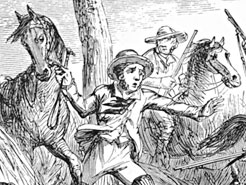The Uncle Tom’s Cabin ExhibitThe Lost Museum Archive

The most famous American novel of the nineteenth century, Harriet Beecher Stowe’s Uncle Tom’s Cabin was first published in 1852 in serial form in the abolitionist newspaper National Era. Stowe’s novel sold an astonishing 300,000 copies in its first year, and was read by more than one million people by the time slavery was abolished. The sentimental novel, which told the tale of runaway slaves, a cruel overseer, and the effect of slavery on families, galvanized slavery’s critics and enraged its defenders. Quickly adapted for the stage by George Aiken, many more theatrical (and later film) versions of Stowe’s story occupied American culture throughout the 1850s and beyond, from the “Tom Shows” of the post Civil War years to vaudeville and silent films in the early twentieth century. Many stage and screen versions were little better than minstrel show presentations, and virtually all were performed by white performers in blackface makeup.
The version of Uncle Tom’s Cabin (adapted by H. J. Conway) that played at the American Museum’s Lecture Room in 1853 artfully undercut the novel’s strong abolitionist politics and instead promoted sectional compromise. Because existing U.S. copyright law did not grant authors control over adaptations of their work, Stowe could only look on in horror at the many versions of her story. Uncle Tom’s Cabin was not the only Lecture Room drama to take on the politically charged topic of slavery; Barnum also presented Dred, a theatrical adaptation of another Stowe novel, and The Octoroon, by Louisiana playwright Dion Bouccicault. All three plays sparked heated debate over the question of abolition and the intersection of politics and theatre. But Barnum was careful to move with changing political tides, and by 1856 George L. Aiken’s more faithfully abolitionist adaptation of Uncle Tom’s Cabin had replaced Conway’s anti-abolitionist version on the Lecture Room stage.